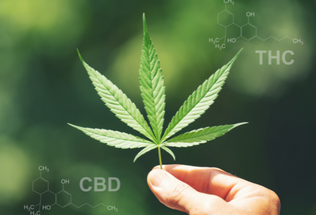Posted by Greg Collmann - Staff Writer on 27th Jun 2023
THC and CBD: What Happens on the Inside?
In this blog, we’re focusing on the two most popular and well known Cannabinoids and how they interact with our bodies’ Endocannabinoid system. With so much information floating around about these two powerful molecules, we wanted to shine a light on what they actually do in your body.
Cannabinoid Compounds in Cannabis
Cannabis contains a variety of compounds known as cannabinoids, among which the most abundant are THC (Δ-9-tetrahydrocannabinol) and CBD (cannabidiol). Although CBD and THC are the most prominent and familiar cannabinoids, scientists have discovered up to 180 different cannabinoids in cannabis. Both THC and CBD interact with the body's endocannabinoid system, but their effects differ due to their different chemical structures and the way they interact with the cannabinoid receptors.
Where are THC and CBD found in nature?
Both THC, CBD, as well as dozens of other cannabinoids are found in most varieties of cannabis. In fact, one of the things science uses to classify a cannabis plant as “hemp” or “marijuana” is which molecule is dominant. Cannabis plants with a dominant production of CBD are classified as Type III cannabis or “hemp”, while plants with dominant production of THC are considered Type I cannabis or “marijuana”. It is important to understand that Delta 9, Δ9, D9, and THC are different terms for the same molecule and that there is no difference between delta-9 THC sourced from hemp and delta-9 THC sourced from marijuana.
The Endocannabinoid System
The endocannabinoid system in the human body consists of endogenous cannabinoids, also known as endocannabinoids, and two primary cannabinoid receptors - CB1 and CB2. These receptors are found throughout the body, including the brain and many organs. CBD and THC interact with these receptors to produce their effects. The Endocannabinoid System or ECS regulates everything from pain to anxiety, appetite and sleep, hormones, communication throughout the body, and more.
THC and its Interactions
THC is the primary psychoactive compound in cannabis. It binds primarily to the CB1 receptors, which are highly present in the brain, leading to the classic 'high' or euphoria associated with cannabis use. When THC is metabolized when ingested as an edible, it primarily turns into 11-hydroxy-Δ9-tetrahydrocannabinol and then into the non-psychoactive metabolite THC-COOH [11]. When consumed (for example, through inhalation), THC and its metabolites enter the bloodstream rapidly via the lungs, reaching peak levels within 6 to 10 minutes and then distributing to the brain and various organs. Ingesting THC will result in a longer wait time before effects are felt than inhaling THC as the THC must be digested and then processed by the liver. Activation time and effects of ingested THC can range widely from person to person depending on a variety of factors including metabolism rate and the presence or lack of certain liver enzymes. Other factors include whether THC is ingested on an empty stomach or with food, as well as types of foods it is taken with - for example, fats tend to help process THC more efficiently.
CBD and its Interactions
CBD, on the other hand, is non-psychoactive and doesn't create the 'high' that THC does. Its mechanism of action is more complex and research in this area continues to evolve. CBD doesn't bind to the cannabinoid receptors in the same way that THC does. Instead, it is believed to interact with multiple molecular targets, potentially including the CB1 and CB2 receptors, but it doesn't bind to these receptors directly as THC does.
Distinct Pharmacological Effects
These differential interactions with the cannabinoid receptors and other targets in the body result in distinct pharmacological effects. THC's activation of CB1 receptors, particularly in the brain, leads to psychoactive effects, while CBD's interaction with multiple molecular targets can result in a myriad of benefits and various non-psychoactive effects.
Summary
In summary, the THC and CBD molecules' behaviors in the body involve interactions with the endocannabinoid system, primarily through the CB1 and CB2 receptors, leading to diverse effects. THC produces psychoactive effects primarily through activation of CB1 receptors, while CBD's action involves multiple molecular targets. The metabolism of these compounds depends on the route of consumption and results in these molecules and their metabolites being distributed throughout the body.
